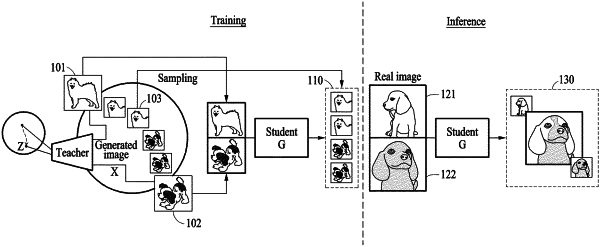| CPC G06T 3/4007 (2013.01) [G06N 3/045 (2023.01); G06N 3/088 (2013.01); G06T 3/4046 (2013.01); G06T 5/50 (2013.01); G06T 2207/20081 (2013.01); G06T 2207/20084 (2013.01)] | 15 Claims |

|
1. An image processing method, comprising:
for each of a plurality of input images, extracting a content latent code of an input image based on a content encoder configured to extract a feature of a content of an image; and
extracting a style latent code of the input image based on a style encoder configured to extract a feature of a style of an image;
obtaining a content feature vector by calculating a weighted sum of content latent codes extracted from the input images based on a morphing control parameter;
obtaining a style feature vector by calculating a weighted sum of style latent codes extracted from the input images based on the morphing control parameter; and
generating a morphing image based on the content feature vector, the style feature vector, and a decoder configured to generate an image from an embedding vector;
wherein a morphing generator including the content encoder, the style encoder and the decoder is trained based on at least one of:
an adversarial loss associated with a discrimination between an image comprised in a training data and an output morphing image obtained from the morphing generator; or
a pixel-wise reconstruction loss associated with a difference between pixels of the image comprised in the training data and pixels of the output morphing image,
wherein, the training data includes a first image, a second image, and a ground truth morphing image,
wherein the ground truth morphing image is generated by linearly interpolating a first point corresponding to the first image sampled in a latent space by a pretrained model and a second point corresponding to the second image sampled in the latent space by the pretrained model.
|